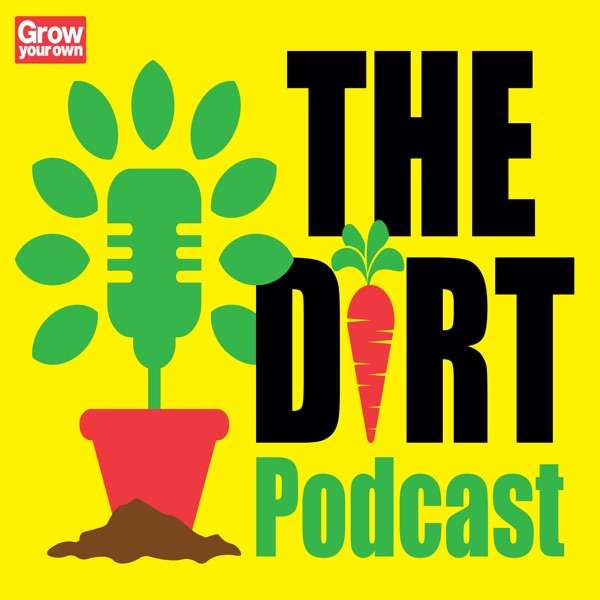Replay of The Wisconsin Vegetable Gardener Radio Show from 5-25-19
Heard on 860AM WNOV & W293cx 106.5FM Milwaukee, WI Saturday mornings 9-10AM CST
Heard on WAAM 1600 AM Ann Arbor, MI Sundays 7-8AM est
Heard on WWDB 860 AM Philadelphia, PA Sundays 7-8AM est
Heard on KMET 1490 AM Tuesdays 9 - 10 AM pst Banning, CA
listen here during show hours for your station:
WNOV https://tinyurl.com/y8lwd922
WWDB: https://wwdbam.com/
WAAM https://tinyurl.com/p68cvft
KMET https://www.kmet1490am.com/
Check out https://thewisconsinvegetablegardener.com/
Contact Joey and Holly:
Email them at TWVGshow@gmail.com
Reach the show anytime through the Instant access text hotline 414-368-9311
Thank you for listening and downloading the show.
Topics: Joey and Holly talks Talk about 10 bugs that you want in your garden
Not all bugs are bad, and knowing which is friend and which is foe may be more important than ever to gardeners this year
Here are some of the herbs, vegetables and flowers she suggests will attract a wide variety of insects:
Make your garden as diverse as possible
Gardening Strategies That Attract Beneficial
Insect allies hate dust. Keeping the soil covered at all times, either with mulch or with growing plants, conserves moisture, moderates temperatures, and eliminates dust. It also provides habitat for ground and rove beetles. Try not to eliminate every weed. Leave some for the insects.
Before we get into our list, it is important to take a moment to consider why exactly you should turn to this method of biological pest control instead of merely grabbing the insecticide at the first sign of a spring aphid.
You don’t have to use chemical pesticides
This approach is totally organic
You will save money on pest control
You will help balance the ecosystem
It improves your soil
Many insects are resistant to pesticides. However, they’re not resistant to being eaten by a predator
You will be able to attract more pollinators
It requires little to no effort!
Remember, filling your garden with beneficial insects means that any chemical pesticide you use will harm them along with the bugs you are trying to eradicate. It is a good idea to avoid chemicals for the health and wellbeing of your family and pets as well.
Baby’s breath
Carrots
Dill
Feverfew
Goldenrod
Lavender
Lemon balm
Marigolds
Mustard
Nasturtiums
Parsley
Queen Anne’s lace
Rose-scented geraniums
Spearmint
Sunflowers
Sweet alyssum
Thyme
Ten good bugs you want in your garden
1. Bees Though this one should be obvious, bees are essential for the pollination of any garden. If you grow any type of fruit or vegetable or pollinating flowers, you will want to make your yard is a happy home for the bees.
How to attract them: Plant perennials, colorful annuals, and lots of fruits and veggies. Bees will come wherever there is nectar to be had.
Ladybug
Preys: aphids, whitefly, mites, fleas, Colorado potato beetle
Attracted by: Dill, Dandelion, Fern-leaf Yellow, Basket of Gold, Common Yarrow
Facts: Ladybugs can consume more than 5,000 aphids during their lifetime.
2. Praying Mantis
Preys: wide range including caterpillars, moths, beetles, and crickets
Attracted by: tall grasses and shrubs, cosmos, marigolds, dills
Facts: Mantis can turn their heads 180 degrees to view their surroundings.
3. Spiders
Preys: wide range including bed bugs, aphids, roaches, grasshoppers, mosquitoes, and fruit flies
Attracted by: tall plants for weaving spiders, mulch for predatory spiders
Facts: Most spiders complete their life cycle in one year.
4. Ground Beetles
Preys: slugs, caterpillars, ants, Colorado potato beetles, cutworms
Attracted by: evening primrose, amaranthus, clover
Facts: Ground beetles are typically only active at night.
5. Aphid Midges
Preys: aphids
Attracted by: Dills, plants with plenty of pollen and nectar, source of water
Facts: aphid midges can attack over sixty types of aphid species.
6. Braconid Wasps
Preys: tobacco hornworm, tomato hornworm, caterpillars, aphids
Attracted by: Fern-leaf Yarrow, Common Yarrow, Dill, Lemon Balm, Parsley
Facts: Braconid wasps kills hornworms by laying eggs inside the caterpillar.
7. Damsel Bugs
Preys: caterpillars, mites, aphids, potato beetles, cabbage worms
Attracted by: Caraway, Fennel, Alfalfa, Spearmint, Peter Pan Goldenrod
Facts: damsel bug populations can thrive if you provide them alternative places to hide.
8. Green Lacewings
Preys: aphids, whitefly, leafhopper, mealybugs, caterpillars of pest moths
Attracted by: Dill, Angelica, Golden Marguerite, Coriander, Dandelion
Facts: the larvae does the actual job of getting rid of soft-bodied pests.
9. Minute Pirate Bugs
Preys: spider mites, insect eggs, caterpillars, aphids, thrips
Attracted by: Caraway, Fennel, Alfalfa, Spearmint, Peter Pan Goldenrod
Facts: both immature stages and adults prey on a variety of small insects.
10. Soldier Beetles
Preys: grasshopper eggs, aphids, soft-bodied insects
Attracted by: goldenrod, zinnia, marigold, linden trees
Facts: soldier beetles do not damage plants and are harmless to people.
11. Tachinid Flies
Preys: gypsy moths, Japanese beetles, cutworms, squash bugs
Attracted by: carrots, cilantro, dill, coriander, buckwheat
Facts: Tachinids parasitize pests by laying eggs onto the host or onto nearby foliage.
12. Hoverflies
Preys: aphids, scale insects, caterpillars
Attracted by: Fern-leaf Yarrow, Common Yarrow, Dill, Basket of Gold, Statice
Facts: Hoverfly larvaes feed on pests, while the adult flies feed on pollen.
13. Mealybug Destroyer
Preys: mealybugs (not all species)
Attracted by: fennel, dill, angelica, sunflower, goldenrod
Facts: One mealybug destroyer can eat up to 250 mealybug larvae.
14. Predatory Mites
Preys: spider mites
Attracted by: humid environments like greenhouses and high tunnels
Facts: predatory mites feed on the pollen, and not the plant itself, when prey is unavailable.
in segment 2 Joey and Holly talk about what are nematodes:
Often referred to as roundworms, nematodes are not closely related to true worms. They are multicellular insects with smooth, unsegmented bodies. The nematode species that feed on plants are so tiny that you need a microscope to see them. The adults often look long and slender, although some species appear pear-shaped. These plant parasites are not the same roundworms as the filarial nematodes that infect the human body, spread diseases, and wreak havoc on the immune system.
Some nematodes feed on the outer surfaces of a plant while others burrow into the tissue. Soil-dwelling nematodes are the most common culprits, but some species can damage plant roots, stems, foliage, and flowers.
No matter where they feed, these tiny worms can seriously damage to crops with their sharply pointed mouths by puncturing cell walls. The real damage occurs when a nematode injects saliva into a cell from its mouth and then sucks out the cell contents. The plant responds to the parasitic worms with swelling, distorted growth, and dead areas. Nematodes can also carry viruses and bacterial diseases inject them into plants. The feeding wounds they make also provide an easy entrance point for bacteria and fungi.
Beneficial nematodes that enrich the soil may feed on the decaying material, insects, or other nematodes.
What Nematodes Look Like
Unlike most other disease-causing organisms, plant-parasitic nematodes seldom produce any characteristic symptoms. Most of the symptoms that do appear are vague and often resemble those caused by other factors — such as viruses, nutrient deficiencies, or air pollution. Nematodes feeding aboveground may cause twisted and distorted leaves, stems, and flowers.
If nematodes are feeding on the roots, a plant may look yellowed, wilted, or stunted and infected food crops will usually yield poorly. If you suspect worm injury to roots, carefully lift one of the infected plants and wash off the roots for easier inspection. If nematodes are causing damage, you may see small galls or lesions, injured root tips, root rot, or excessive root branching.
How They Spread
Whether they feed above or below ground, most nematodes spend at least part of their life cycle in the soil. While they can’t move very far under their own power, they can swim freely in water and they move more quickly in moist soil — so it's a good idea to keep your soil well-drained. They also spread by anything that can carry particles of infested soil, including tools, boots, animals, and infected plants.
What About Beneficial Nematodes?
Beneficial nematodes can range from 1/25 inch to several inches long and have slender, translucent, unsegmented bodies. Their roles in the garden vary. Some are soil dwellers that break down organic matter, especially in compost piles. You can easily spot these 1/4-inch-long decomposers.
These types actually combat a variety of pest species, including weevils, clearwing borers, cutworms, sod webworms, chinch bugs, and white grubs. Nematodes attack and kill these insects by either injecting deadly bacteria or entering the host, parasitizing, and then feeding on it.
Get rid of nemotodes
Remove plants and dig up the roots at the end of each growing season to remove the nematodes' food source. Dispose of the plant matter. Till the soil after removing the plants to dry the soil and expose the nematodes to sunlight, which kills them.
In segment 3 Joey and Holly talk with their guest Jill Winger from https://www.theprairiehomestead.com/
Jill Winger is a blogger of The Prairie Homestead and author of The Prairie Homestead Cookbook. It’s Jill’s mission help modern folks create a richer, slower, more meaningful life through this crazy-beautiful thing we call modern homesteading. She lives on a 67 acre prairie homestead with her husband and 3 children and who knows how many farm animals.
How did you get into homesteading? Is that how you or your husband grew up?
Even if you live in a studio apartment in a high rise in the middle of a busy city, how can one be a modern homesteader?
Lets talk about your book - The Prairie Homestead Cookbook - can you tell us more about it - what is in it? Anything you want to highlight in there?
A lot of gardeners, canners, homesteaders can get burnt out or have time management issues, how do you deal these problems?
What are some tips for gardening in a cold climate?
Tell us more about where to find you and your book?
In segment 4 Joey and Holly answer gardeners questions
1. Chrislyn asked How did your leeks do that you planted in the sq ft garden methods last year
A: The ones that were planted 9 per square ft were small the ones that 4 per sq ft were good size
2.What type of fruit/veggie would you recommend for a very, very sandy soil ??
1 Carrot
2 Parsnip
3 Beet
4 Radish
5 Aromatic herbs (rosemary, sage, thyme, oregano)
6 Onion
7 Garlic
8 Potato
9 Asparagus
10 Turnip
3. Ruth Is there anything I can use that really will kill thistles in my veggie garden? I’ve been digging many times a year & it only gets worse. I don’t want to destroy the soil so that nothing will grow.
A: .BioSafe of www.biosafe.net Garden line offers a diverse array of eco-friendly products to support all facets of plant life, products that do not leave a lasting footprint Save 10% on your next order use coupon code TWVG at checkout.
4 Q I found worms in my containers which I did not put there. You have said in your video not to add worms to container should I try remove them ?
5. can i plant carrots in 45 temp soil?
A yes 45F
6. Are weed barriers good and show I put irrigation under it?
Tweet us at #twvg or @twvgshow
The show runs March - Oct
Check out the following sponsors that make the radio show possible: Thank you
Power Planter of www.powerplanter.com
IV Organics of www.ivorganics.com
Dr. Earth of www.drearth.com organic
Root maker of www.rootmaker.com
Flame Engineering Inc. of www.flameengineering.com Use coupon code WVG19 to get free shipping.
Pomona Universal Pectin of www.pomonapectin.com
Bobbex of www.Bobbex.com:
Beans & Barley of www.beansandbarley.com
MIgardener of www.MIgardener.com
Outpost Natural Foods Co-op of www.outpost.coop
Root Assassin of www.rootassassinshovel.com .
Handy Safety Knife of www.handysafetyknife.com Use promo code WVG to get 10% off &free shipping one time use only
BioSafe of www.biosafe.net Save 10% on your next order use coupon code TWVG at checkout
Chapin Manufacturing Inc. of www.chapinmfg.com
Pro Plugger of www.proplugger.com
Dharmaceuticals of www.dharmaceuticals.com
Soil Savvy of www.mysoilsavvy.com Use coupon code TWVG19 to save 10% at checkout
Tomato Snaps of www.tomatosnaps.com
Drip Garden of www.dripgarden.com Drip Garden
Wisconsin Greenhouse company https://wisconsingreenhousecompany.com/
Standard Process Inc. of www.standardprocess.com
Big Fat’s Hot Sauce of www.bigfatshotsauce.com
Soil Diva of www.soildiva.net
World’s coolest floating rain gauge of www.WorldsCoolestRainGauge.com
Clyde’s vegetable planting chart of www.clydesvegetableplantingchart.com
NuNu Natural Healing of www.nunuhealing.com
RowMaker of www.rowmaker.com
Eco Garden Systems of www.ecogardensystems.com Use coupon code (wiveg2019) and get $295 off the list price of $1,695 PLUS free shipping (a $250 value).
Shield n seal of www.shieldnseal.com
Bluemel's garden & landscape center of www.bluemels.com
Phyllom BioProducts of PhyllomBioProducts.com
Norwalk juicers of www.norwalkjuicers.com Use coupon code Garden talk Free Continental US shipping on the Model 290 Juicer
Tree Ripe of WWW.tree-ripe.com
Hydrobox of https://gohydrobox.com/

 Our TOPPODCAST Picks
Our TOPPODCAST Picks  Stay Connected
Stay Connected







